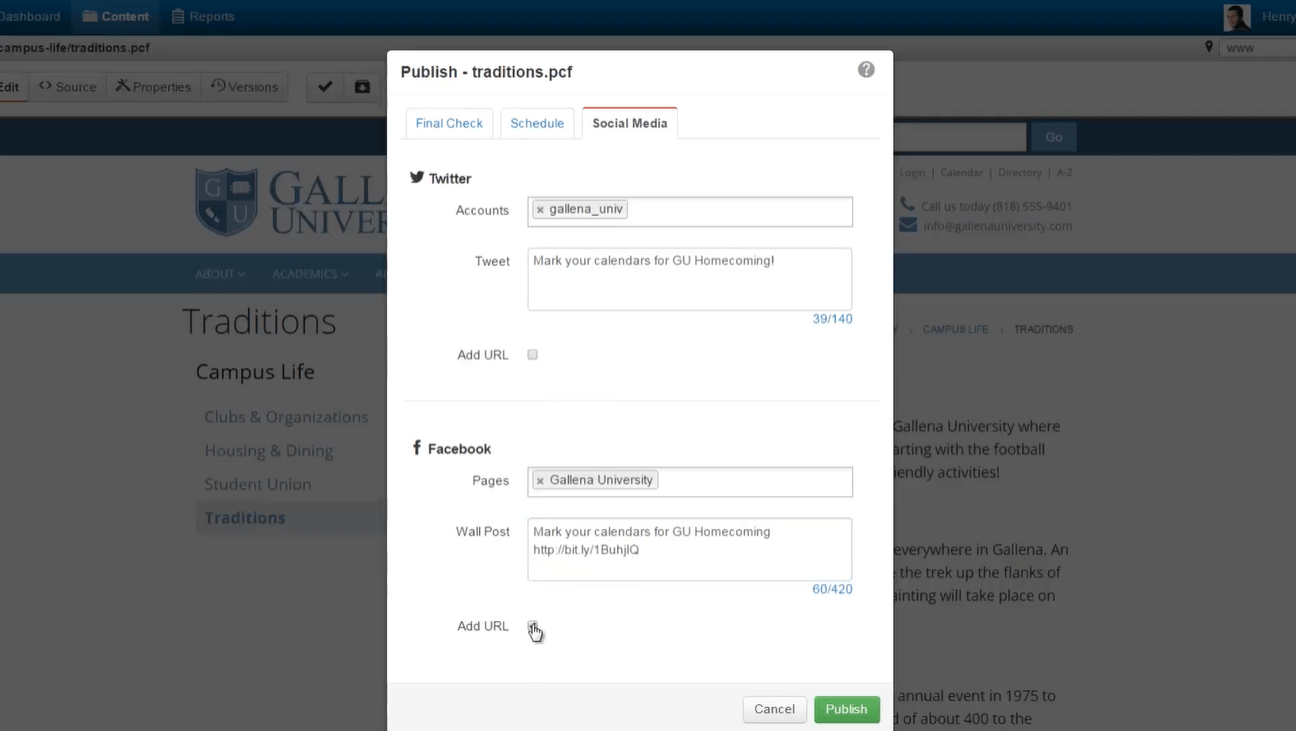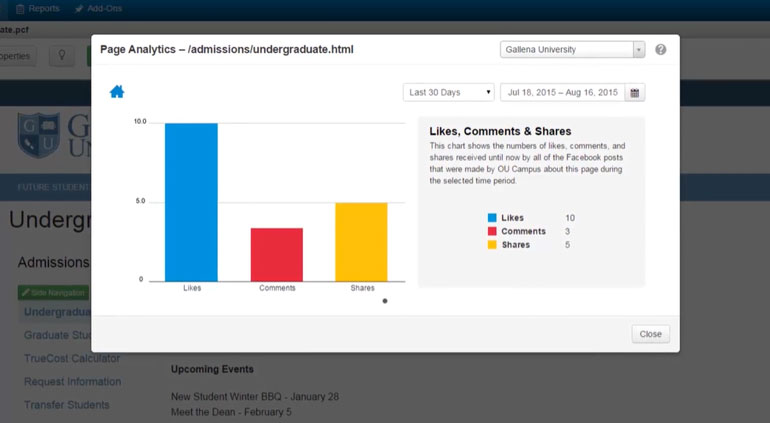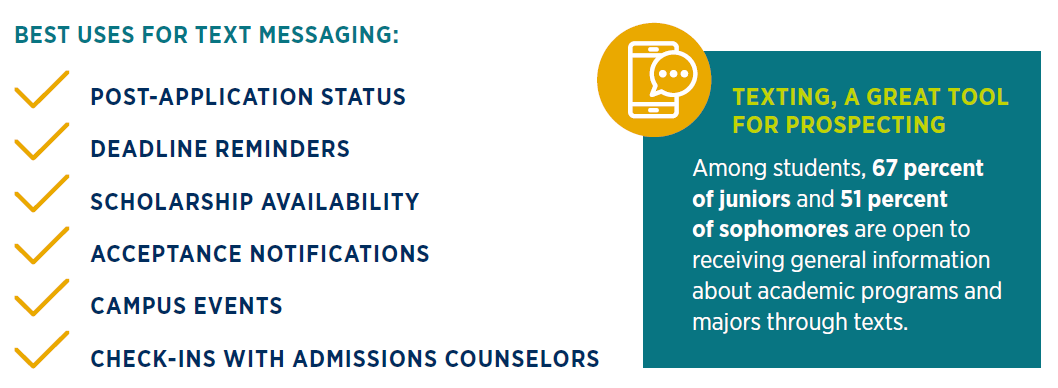Social Media Marketing for Colleges and Universities: 8 Tips
Does your college or university have a targeted direct mail campaign to reach prospective students? As the mother of a high school senior, let me give you some advice: Save your money and focus your marketing efforts online.
This past summer, the onslaught of postcards and thick packets began arriving. Stacking them neatly on the table in my hall, I got excited just thinking about the possibilities hidden within each piece of mail. Guess what? After 4 months, that stack grew so unwieldy that I threw them all away, untouched. Despite my reminders and even laying out a couple of the glossy catalogs on the table, my daughter never gave them a second thought. In one argument, I asked her how she expected to learn about different colleges and what they offered. Her reply?
“Anything I want to know, I can google.”
Your online presence is critical, and that includes social media. Social media is the go-to media for reaching younger generations. Even if your school is already doing social media, this article can help you:
- Understand what a social media marketing strategy can do for your college.
- Create a social media plan.
- Learn tips to up your social media game.
CTA = Download a copy of the 2019 E-Expectations® Trend Report to understand digital trends among high school students and target your marketing efforts to the right audience.
Download trend report now!
What can a social media marketing strategy do for my college or university?
According to Pew Research, younger Americans embrace a variety of platforms that they visit multiple times daily. This provides your school with several opportunities to advertise and gain optimal visibility.
More than any other reason, a social media marketing strategy gets you face time with your target audience. Because most prospective students get their information digitally, you can meet them where they are with a strategic online marketing campaign across all social media platforms.
There are other reasons to enhance your college or university social media strategy:
- It’s a great recruitment tool. Videos depicting campus life and events show students what it’s like to be a student at your school.
- It’s a quick way to disseminate information. Guest speakers, sporting events, and even emergencies can be pushed out to the public immediately.
- It lets you engage your audience directly. Platforms like Twitter are ideal for asking questions to your audience. Use it for polls or to glean student preferences.
How do I create my college or university’s social media marketing plan?
Exactly what is it that you want to do? Recruitment? Fundraising outreach? Student engagement? Answering this question gives you the backbone of your social media plan.
The next steps fall easily into line:
Determine what outcome you want from your college or university social media strategy.
Do you want to gain more followers? Increase the number of prospective students who visit campus? Build a stronger social media presence in general? Knowing your outcome gives you something to work toward as you implement your social media strategy.
Decide who is in charge of what.
Who will develop an editorial calendar and post content? What voice/tone do you want to use across multiple platforms? What platform will be used for what purpose? Creating a strong plan and then sharing it campus-wide will get your entire team—and school—on the same page.
Create audience personas.
An audience persona simplifies “audience” into specific character types, or personas. For example, you might have a prospective student, first-generation student, transfer student, parent, donor, and alumni—all of who are relevant, but very different parts of your collective target audience.
Be specific about defining your goal.
Make sure to define and include all key performance indicators (KPIs) you need to measure whether your campaign is a success.
What are a few social media marketing strategies for higher education?
Don’t reinvent the wheel. Instead, see what other schools are doing and then personalize these ideas to work best for your college or university’s social media marketing strategy.
Here are eight social media marketing tips to consider:
1. Automate repetitive tasks.
A quality content management system (CMS) allows you to schedule content for platforms such as Twitter and Facebook. Such automation of repetitive tasks frees you for more important work.

CAPTION = A quality CMS allows you to simultaneously push content to your social media channels when publishing pages on your website.
2. Get current students and alumni involved in content creation.
Having current students and alumni create, curate, and publish presents your school’s most authentic voice, because these are the people who have lived and are living your school’s experience. Prospective students appreciate the genuineness of content coming from real people and real experiences.
3. Create a “student ambassador” program where different students take over an account and walk viewers through their daily activities.
Guest posts from students in specific colleges, study abroad programs, campus activities, and athletics give viewers a “day in the life” glimpse of niche areas of campus life.
For instance, Texas Christian University’s #tcustudyabroad posts adventures on Instagram from students involved in exchange programs in various parts of the world—a stellar social media marketing strategy.

– Image courtesy of Texas Christian University
4. Use data to measure engagement.
Data about the performance of your social media channels provides insight that you can use to make improvements that enhance your school’s digital presence. A robust CMS will have analytics from social channels integrated when you publish via the CMS. Make sure to keep track of different metrics such as likes, shares, views, video watch time length, among others, to determine what your audience responds to and what they don’t.

CAPTION = A quality CMS will have strong reporting features integrated such as social media analytics.
5. Maintain a cohesive voice/persona across all your accounts.
Because voice is part of your school’s brand, it should be consistent no matter what medium you are using. If you do decide on a more formal tone, take time to explain any academic terms that may not be familiar to some students.
6. Maximize the strengths of different platforms.
Instagram, YouTube, and Twitter are holding steady as top platforms for this new generation. This makes sense: they’re visual and quick. Information is succinct and “fluff-free.” If you’re a techie, venture into newer social platforms like Tik-Tok. Snapchat has been around for a while, but colleges have yet to take full advantage of the platform. And don’t forget texting. It is effective in getting the conversation started and keeping it going.

CAPTION = According to the 2019 E-Expectations® Trend Report, texting has surged in popularity over the last couple of years. It’s one of the easiest ways to get messages in front of students.
7. Create a comprehensive editorial calendar that includes what will be posted across all channels.
The more organized and coordinated your social media efforts, the better your success. Take time to schedule content based on annual events, holidays, important campus milestones, deadlines, and program schedules.
8. Prioritize responsiveness and engagement.
Your social media accounts represent your institution, so anything posted will be considered an “official” stance. That’s why it’s so important to vet what you plan to post through this lens. Also pay attention to what others are saying to and about your college or university online and, if possible, join in those conversations with your audience. This will strengthen connections and give your institution a positive online personality.
Wrapping up: Why is social media marketing so important?
Every year, data from the E-Expectations Trend Report confirms that a college or university’s digital presence is an important part of an institution’s overall persona. As this generation of digital natives continues to mature, you can expect that the influence of your online messaging will become even more crucial in sharing your school’s brand. Don’t wait until you’re so far behind that it feels impossible to catch up. Instead, go ahead and implement the strategies suggested, even if it’s one at a time, to make sure your social media strategy is not only executed, but on point.
Don’t waste time—Download the 2019 E-Expectations® Trend Report and get started today in learning about the digital habits of high school students.
Last updated: February 5, 2021


